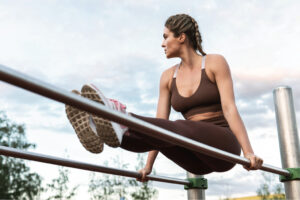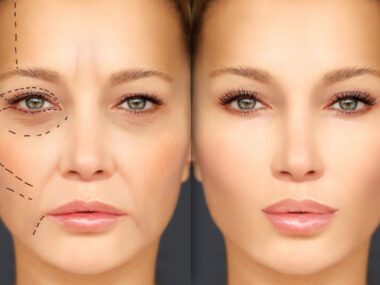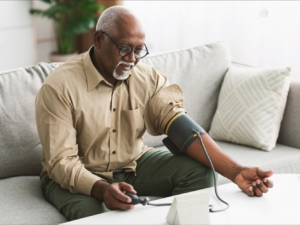Calisthenics exercise is a form of exercise that focuses on using your body weight to build strength, flexibility, and overall fitness. It involves performing a variety of bodyweight exercises that target different muscle groups, often without the need for any equipment.
 Certainly, it can be done almost anywhere, making it a convenient and accessible way to stay in shape.
Certainly, it can be done almost anywhere, making it a convenient and accessible way to stay in shape.
Also, it is effective at developing functional strength, which means the strength and skills gained from these exercises directly translate to real-world movements and activities.
Unlike some traditional weightlifting exercises that isolate individual muscles, calisthenics focuses on compound movements that engage multiple muscle groups simultaneously.
How calisthenics exercises translate to functional strength
- Full-Body Engagement: Calisthenics exercises often require coordination and balance, engaging various muscle groups together. Also, this is similar to how your body naturally moves in everyday tasks.
- Natural Movement Patterns: Many calisthenics movements mimic real-world activities. For example, squats replicate the motion of sitting and standing, while pull-ups imitate actions like climbing or lifting yourself over obstacles.
- Core Strength and Stability: Core muscles are crucial for maintaining posture, balance, and stability during calisthenics exercises. This core strength translates to better posture and stability in daily activities.
- Improved Mobility: Calisthenics exercises often involve dynamic movements that improve joint mobility and flexibility. This translates to greater ease of movement in daily life.
- Functional Fitness: The strength gained from calisthenics can improve your ability to perform everyday tasks, such as carrying groceries, lifting objects, and getting in and out of a car.
- Adaptability: Calisthenics requires the body to adapt to varying movements and positions. This adaptability prepares you for a wide range of movements and challenges you might encounter in everyday life.
- Compound Movements: Calisthenics exercises frequently involve compound movements that engage multiple joints and muscle groups simultaneously. This closely mirrors how your body functions in real-world activities.
- Real-World Applications: Many calisthenics movements are directly applicable to common activities. For instance, pushing exercises like push-ups mimic actions like pushing a heavy door open, and pulling exercises like pull-ups simulate movements like pulling yourself up over a ledge.
- Improved Posture: Calisthenics emphasizes core strength and overall body awareness, which can lead to improved posture and reduced risk of posture-related issues.
- Increased Endurance: Calisthenics workouts often incorporate cardio and endurance aspects, improving your ability to sustain physical activity over time.
- Functional Balance: Balancing exercises in calisthenics help enhance proprioception (awareness of body position) and balance, which are essential for activities like walking on uneven surfaces.
- Reduced Risk of Injuries: Functional strength gained from calisthenics can contribute to better joint stability and proper movement mechanics, reducing the risk of injuries during daily activities.
principles of calisthenics exercise

- Bodyweight Resistance: Calisthenics exercises use your own body weight as resistance to build strength and muscle.
- Functional Fitness: Many calisthenics exercises mimic natural movements, making them useful for everyday activities and improving overall fitness.
- Progressive Overload: As you become stronger, you can make exercises more challenging by increasing the intensity, repetitions, or variations.
- Minimal Equipment: While some calisthenics routines may incorporate simple equipment like bars or rings, many exercises can be performed without any equipment.
Other Calisthenics exercises
- Push-Ups: Target chest, shoulders, and triceps. Variations include wide grip, diamond push-ups, and decline push-ups.
- Pull-Ups/Chin-Ups: Engage the back, biceps, and shoulders. Variations include wide grip, narrow grip, and muscle-ups.
- Dips: Focus on the triceps and chest. You can perform these using parallel bars or even between two sturdy surfaces.
- Squats: Work the legs and glutes. Variations include pistol squats and jumping squats.
- Planks: Strengthen the core muscles and improve stability. Variations include side planks and plank leg lifts.
- Lunges: Target the legs and glutes. You can go forward, reverse, and lateral lunges.
- Burpees: A full-body exercise that combines squats, push-ups, and jumps for a cardiovascular workout.
- Hanging Leg Raises: Engage the core and hip flexors while hanging from a bar.
- L-Sits: A challenging exercise that targets the core and requires balance and strength to hold your legs straight in an L-shaped position.
- Handstands: Strengthen the shoulders and core, and improve balance. Progressions can lead to handstand push-ups.
Benefits of Calisthenics:
- Strength: Calisthenics builds functional strength that translates to real-world movements.
- Flexibility: Many calisthenics exercises involve dynamic stretches that improve flexibility over time.
- Balance and Coordination: The movements engage various muscles, promoting better coordination and balance.
- Convenience: Calisthenics can be done at home, in a park, or even during travel.
- Minimal Cost: You don’t need expensive gym equipment to get started.
In addition, Calisthenics is suitable for various fitness levels, as exercises can be modified to accommodate beginners or advanced practitioners.
Also, like any exercise, it’s important to warm up properly, maintain good form, and progress gradually to avoid injury.
Finally, If you’re new to calisthenics, consider seeking guidance from a fitness professional instructor who offers step-by-step instructions and progressions for different exercises.










